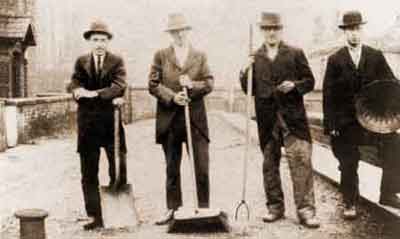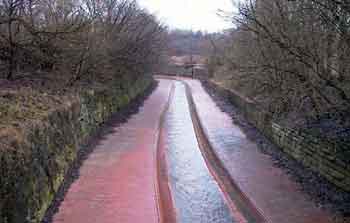
The photograph below, dating from c.1920, shows four canal employees of the Great Central Railway Company at the side of Park Lock (lock 7). The question is just precisely what were these workmen doing posing, from left to right, with a shovel, brush, pitchfork (pikel in Lancashire dialect) and dustbin lid? The spot they are standing on looks clean and tidy enough and it could be that this gang was about to embark on another clean-up operation close by. In terms of weed removal there would have been little, if anything, for them to do as practically no vegetation could grow in this vicinity as it was dominated by numerous chemical works, Stuart Street Power Station, Bradford Colliery and Bradford Gas Works.

Four canal employees of the Great Central Railway Company at the side of Park Lock, c.1920.
The scene also shows the lock-keeper's cottage¹ on the left and Mill Street change bridge² lies across the tail of the lock³. The Navigation Inn is just about visible in the background on the right. The inn was demolished in the 1980s but, following a period of dereliction, the cottage was restored by British Waterways. The last person to occupy the cottage prior to its dereliction was a Mrs Wood who left it to live with relatives.
Park Lock was so named because of its proximity to Philips Park, which is situated on the other side of Stuart Street off the picture on the right. Philips Park was a credit to a staff that somehow, in spite of adverse atmospheric conditions, managed to make plants grow. The park was (and still is) famous for its display of tulips each spring. The river Medlock, which flows alongside in an artificial channel constructed entirely of terracotta tiles, forms the northern boundary of Philips Park. Hereabouts this spectacular feature gave rise to its nickname of 'Red River'. The massive Philips Park Cemetery occupies the opposite bank of the river Medlock. Mark Philips, who was then the Member of Parliament for Manchester, opened Philips Park in 1846 and the cemetery opened in December 1863. This park was the first municipal park of its kind in the country and it set a standard for others to follow.

The river Medlock looking upstream from a bridge connecting Philips Park and Philips Park Cemetery, Jan 2004.
The busy Bradford Private Branch (or Colliery Arm) was located on the south side of the canal between Bradford Lock (lock 6) and Park Lock (lock 7). This first accessed a Coal Yard on one side and Pritchard's Mill on the other and then, after passing below Philips Park Road, there was a second Coal Yard followed by Sharp, Murray & Company's Mill, Richard Johnson & Nephew's Iron and Wire Works and finally Bradford Colliery. It is interesting that this arm actually passed through Bradford Iron Works and, for a short distance, it was actually inside the works before it emerged at the wharfs of Bradford Colliery.